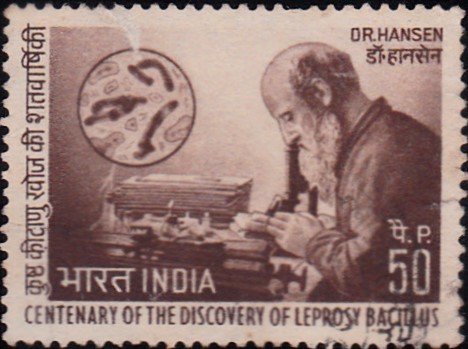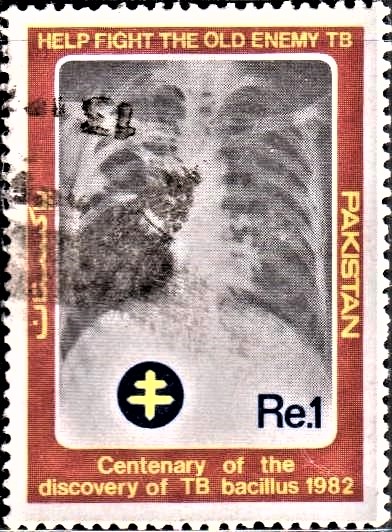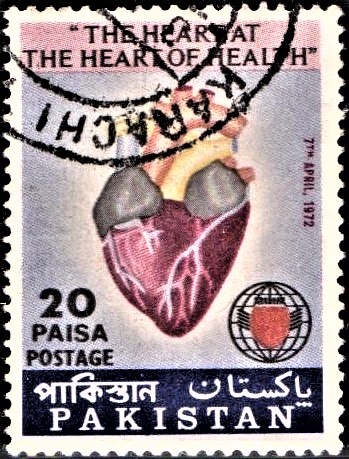
India on Centenary of Discovery of Leprosy Bacillus
A commemorative postage stamp on the Dr. G. Armauer Hansen, a Norwegian physician, identified Mycobacterium leprae bacterium, causative agent of leprosy in 1873 [a part of the series ‘Centenary Stamps Series‘] :
 Issued by India
Issued by India
Issued on Jul 21, 1973
Issued for :
Centenary Series
A set of four stamps are being brought out to commemorate the centenary of the death of Michael Madhusudan Dutt, the well-known poet of Bengal, the centenary of the birth of Vishnu Digambar Paluskar, the eminent musician of India, the centenary of the discovery of leprosy bacillus, and the quin-centenary of the birth of Nicolaus Copernicus, the world renowned scientist.
The P&T Department feels honoured to bring out these stamps in the Centenary Series being issued on 21-7-73.
Description of Design : The stamp is horizontal and shows the scientist looking into the microscope (in order to figure the discovery of the Leprosy bacillus).
Type : Stamp, Postal Used
Colour : Red Brown
Denomination : 50 Paise
Overall size : 3.91 x 2.90 cms.
Printing Size : 3.56 x 2.54 cms.
Perforation : 13 x 13
Watermark : Printed on unwatermarked Adhesive Stamp paper in reels
Quantity printed : 1 Million
Number per issue sheet : 35
Printing Process : Photogravure process
Designed and Printed at : India Security Press, Nasik Road
Name : Gerhard Henrik Armauer Hansen
Born on Jul 29, 1841 at Bergen, Norway
Died on Feb 12, 1912 at Florø, Norway
About :
- Hundred years ago the bacillary cause of Leprosy was discovered by a Norwegian Scientist Dr. G. Armauer Hansen. The opprobrium and curse of Leprosy, which for centuries had weighed on its unfortunate victims, had thence forward no longer any justification. Leprosy took its place among other infectious diseases.
- There remained, however, the problem of finding a specific remedy, and 70 years were to pass before an effective cure became available. From that moment Leprosy became a curable disease, and its dreaded complications can now be prevented provided treatment is begun early. There are, however, two major difficulties : first, Leprosy still continues to evoke an irrational fear; and second, recent statistics reveal that the number of Leprosy sufferers in the world has reached 11 million. When, however, it is realised that in some districts 10 to 45 percent of the patients have the contagious form of Leprosy (called lepromatous) and that young people in contact with these patients are particularly in danger of contracting the disease, the immensity of the remaining task of controlling leprosy is apparent.
- In order to overcome the ill-founded prejudice, laws have been promulgated forbidding the segregation and internment of leprosy patients, and at the same time the principle of domiciliary treatment (as advocated by the World Health Organisation) became generally adopted.
- It is now well recognised that the success of leprosy eradication programmes depends to a great extent on the awareness of the general public about the correct concepts of the disease for which effective remedies are available today. According to the Director-General of Health Services, leprosy is still a major health problem with us mainly because of the fact that “enlightenment of the public and even of the medical profession has lagged far behind medical progress“.








[…] of the birth of Vishnu Digambar Paluskar, the eminent musician of India, the centenary of the discovery of leprosy bacillus, and the quin-centenary of the birth of Nicolaus Copernicus, the world renowned […]
[…] of the birth of Vishnu Digambar Paluskar, the eminent musician of India, the centenary of the discovery of leprosy bacillus, and the quin-centenary of the birth of Nicolaus Copernicus, the world renowned […]
[…] Armauer Hansen, a Norwegian leprologist was the physician who identified the leprosy bacilli. The causation of the disease was not known until he identified the organism under the microscope. Leprosy is also known as Hansen’s Disease. […]